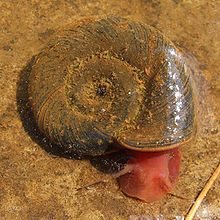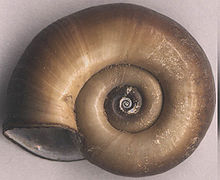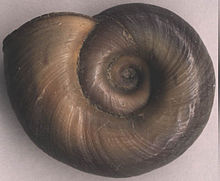- Planorbarius corneus
-
Planorbarius corneus 
A live individual of Planorbarius corneus, carrying the shell with the umbilicus uppermost Conservation status NEScientific classification Kingdom: Animalia Phylum: Mollusca Class: Gastropoda (unranked): clade Heterobranchia
clade Euthyneura
clade Panpulmonata
clade HygrophilaSuperfamily: Planorboidea Family: Planorbidae Genus: Planorbarius Species: P. corneus Binomial name Planorbarius corneus
(Linnaeus, 1758)[1]Subspecies - Planorbarius corneus corneus (Linnaeus, 1758)
- Planorbarius corneus grandis (Dunker, 1850)
Synonyms - Coretus corneus (Linnaeus)
- Planorbis corneus
Planorbarius corneus, common name the great ramshorn, is a relatively large species of air-breathing freshwater snail, an aquatic pulmonate gastropod mollusk in the family Planorbidae, the ram's horn snails, or planorbids, which all have sinistral or left-coiling shells.
The shell of this species appears to be dextral in coiling, even though it is in fact sinistral or left-handed.
Contents
Distribution
The native range of this pond snail is from Europe to central Asia.
- Not listed in IUCN red list – not evaluated (NE)[2]
- Czech Republic – least concern (LC)[3]
- Germany
- Netherlands[4]
- Russia – Sverdlovsk oblast[5]
- Slovakia
- Poland
- British Isles: Great Britain, Ireland
- Slovenia
Description
All species within family Planorbidae have sinistral shells.
Habitat
This large planorbid is found in water which is still, or only moving slowly, where there is a good growth of many different kinds of pond weeds, and where there are high levels of calcium dissolved in the water.[6]
Planorbarius corneus under high temperatures has been studied by Kartavykh & Podkovkin (2002).[7]
Parasites
This species of snail functions as a host for several parasite species:
- as first intermediate host for Prosthogonimus ovatus[8]
- as first intermediate host for Apatemon gracilis[9]
- as first and as second intermediate host for Hypoderaeum conoideum[10]
- as intermediate host for Syngamus trachea[11]
- as intermediate host for Typhlocoelum sisowi[12]
References
- ^ Linnaeus C. (1758). Systema Naturae per regna tria naturae, secundum classes, ordines, genera, species, cum characteribus, differentiis, synonymis, locis. 10th edition. - Vermes. Testacea: 700-781. Holmiae. (Salvius).
- ^ 2006 IUCN Red List of Threatened Species. <www.iucnredlist.org>. Cited 5 March 2007.
- ^ Juřičková L., Horsák M. & Beran L. (2001) "Check-list of the molluscs (Mollusca) of the Czech Republic". Acta Soc. Zool. Bohem. 65: 25-40.
- ^ http://www.anemoon.org/anm/voorlopige-kaarten/zoetwatermollusken/wetenschappelijk/planorbarius-corneus/
- ^ http://ecoinf.uran.ru/content/4catalog/70.shtml
- ^ Janus, Horst, 1965. ‘’The young specialist looks at land and freshwater molluscs’’, Burke, London
- ^ (Russian) Kartavykh T. N. & Podkovkin V. G. (2002) "[Influence of high temperature of environment upon cholinesterase activity in Gastropoda Planorbis corneus]". 152-157. PDF.
- ^ Prosthogonimus ovatus (Parasite Species Summary)
- ^ Apatemon gracilis (Parasite Species Summary)
- ^ Hypoderaeum conoideum (Parasite Species Summary)
- ^ Syngamus trachea (Parasite Species Summary)
- ^ Typhlocoelum sisowi (Parasite Species Summary)
External links
Categories:
Wikimedia Foundation. 2010.


